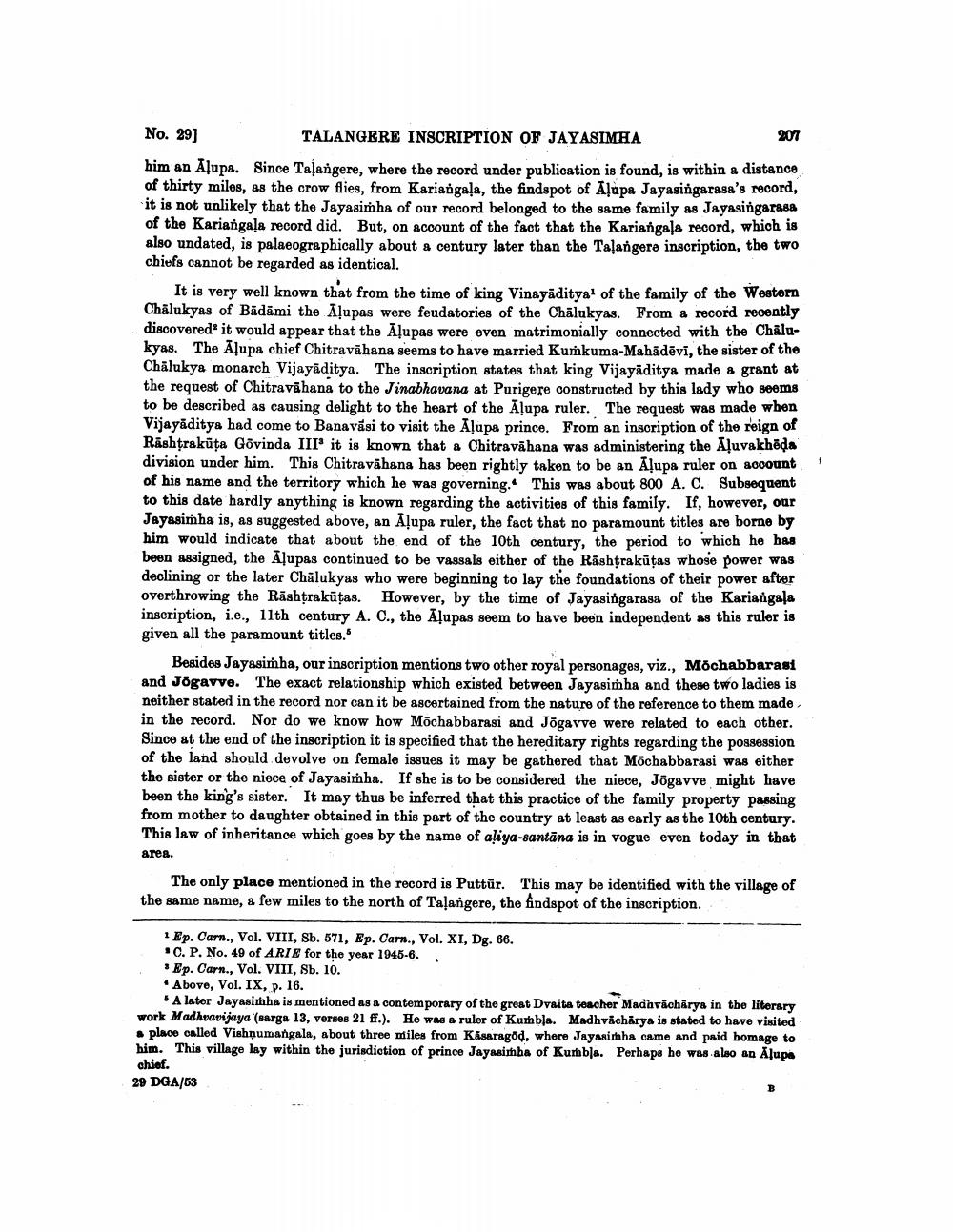________________
No. 29] TALANGERE INSCRIPTION OF JAYASIMHA
207 him an Alupa. Since Talangere, where the record under publication is found, is within a distance of thirty miles, as the crow flies, from Kariangala, the findspot of Alupa Jayasingarasa's record, it is not unlikely that the Jayasimha of our record belonged to the same family as Jayasingarasa of the Kariangaļa record did. But, on account of the fact that the Kariangala record, which is also undated, is palaeographically about a century later than the Talangere inscription, the two chiefs cannot be regarded as identical.
It is very well known that from the time of king Vinayādityal of the family of the Western Chālukyas of Bādāmi the Aļupas were feudatories of the Chālukyas. From a record recently discovered it would appear that the Aļupas were even matrimonially connected with the Chalukyas. The Alupa chief Chitravāhana seems to have married Kumkuma-Mahādēvī, the sister of the Chalukya monarch Vijayaditya. The inscription states that king Vijayaditya made a grant at the request of Chitravāhana to the Jinabhavana at Purigere constructed by this lady who seems to be described as causing delight to the heart of the Alupa ruler. The request was made when Vijayaditya had come to Banavāsi to visit the Alupa prince. From an inscription of the reign of Rashtrakūta Govinda III it is known that a Chitravāhana was administering the Aļuvakheda division under him. This Chitravahana has been rightly taken to be an Alupa ruler on account of his name and the territory which he was governing. This was about 800 A. C. Subsequent to this date hardly anything is known regarding the activities of this family. If, however, our Jayasimha is, as suggested above, an Alupa ruler, the fact that no paramount titles are borne by him would indicate that about the end of the 10th century, the period to which he has been assigned, the Alupas continued to be vassals either of the Rashtrakūtas whose power was declining or the later Chălukyas who were beginning to lay the foundations of their power after overthrowing the Rashtrakūtas. However, by the time of Jayasingarasa of the Kariangala inscription, i.e., 11th century A. C., the Alupas seem to have been independent as this ruler is given all the paramount titles.
Besides Jayasimha, our inscription mentions two other royal personages, viz., Mochabbarasi and Jogavve. The exact relationship which existed between Jayasimha and these two ladies is neither stated in the record nor can it be ascertained from the nature of the reference to them made in the record. Nor do we know how Mochabbarasi and Jögavve were related to each other. Since at the end of the inscription it is specified that the hereditary rights regarding the possession of the land should devolve on female issues it may be gathered that Möchabbarasi was either the sister or the niece of Jayasinha. If she is to be considered the niece, Jögavve might have been the king's sister. It may thus be inferred that this practice of the family property passing from mother to daughter obtained in this part of the country at least as early as the 10th century. This law of inheritance which goes by the name of aliya-santāna is in vogue even today in that area.
The only place mentioned in the record is Puttūr. This may be identified with the village of the same name, a few miles to the north of Talangere, the findspot of the inscription.
1 Ep. Oarn., Vol. VIII, Sb. 571, Ep. Carn., Vol. XI, Dg. 66. 10. P. No. 49 of ARIE for the year 1945-6..
Ep. Carn., Vol. VIII, Sb. 10. *Above, Vol. IX, p. 16.
"A later Jayasitha is mentioned as a contemporary of the great Dvaita teacher Madhvacharya in the literary work Madhravijaya (sarga 13, verses 21 ff.). He was a ruler of Kumbla. Madhvacharya is stated to have visited s place called Vishnumangala, about three miles from Kasaragod, where Jayasimha came and paid homage to him. This village lay within the jurisdiction of prince Jayasimba of Kumbla. Perhaps he was also an Alupa chiof. 29 DGA/53




